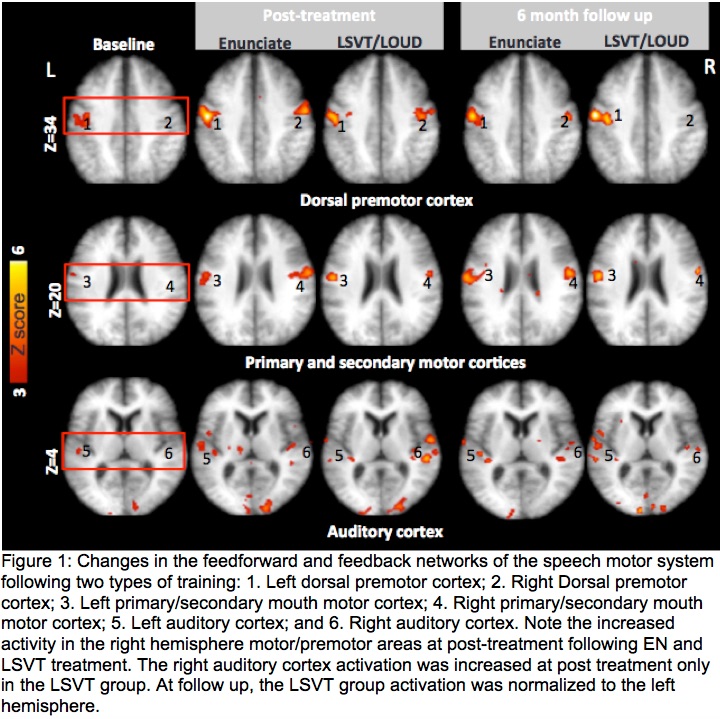Session Information
Date: Thursday, June 8, 2017
Session Title: Parkinson’s Disease: Clinical Trials, Pharmacology And Treatment
Session Time: 1:15pm-2:45pm
Location: Exhibit Hall C
Objective: The aim of the study was to isolate the specific effects of the training target of The Lee Silverman Voice Therapy (LSVT) in Parkinson’s disease (PD).
Background: LSVT, targeting vocal loudness and auditory retraining in an intensive training setting is an effective treatment for PD hypophonia (1). In order to dissociate the specific contributions of training intensity and the training target, we compared the effects of LSVT targeting vocal loudness and articulation (ARTIC) targeting orofacial-articulatory movements, keeping training intensity constant.
Methods: Nineteen patients (11 F) with PD were randomized into LSVT, ARTIC, or untreated groups. Patients in the LSVT and ARTIC were trained on their respective targets for 4 weeks. Changes in vocal intensity (sound pressure level-SPL) and cerebral blood flow as measured by [15O]H2O PET during reading were recorded at baseline, post-treatment and at 6 month follow up.
Results: Behaviorally, both treatments resulted in significant gains in SPL at post-treatment, but the magnitude of change in the LSVT was greater than that following ARTIC and only patients in LSVT group maintained the SPL improvements at follow up. At post-treatment, both training resulted in greater activity in regions of feedforward network (FFN) i.e., bilateral primary and secondary motor and dorsal premotor cortices. Only the LSVT group showed increased activation in the right auditory regions of the feedback network (FBN). At follow up, the ARTIC group maintained the greater activation in the regions of the FFN, but the activity in the FBN was greatly decreased. In the LSVT group, the activations in both FFN and FBN in the left hemisphere remained significant (Fig. 1). In the untreated group, there was progressive decrease in activity in both the FFN and FBN correlating with decreased SPL.
Conclusions: The changes in the FFN observed in both training modes represent an improvement in movement execution induced by training intensity. The changes in the FBN correlating with the improved internalization of voice training intensity induced cuing or recalibration noted only with LSVT indicate to the specific effect of treatment target. We also demonstrate LSVT induced rightward shift of activity in the FFN and FBN of the speech motor system indicating an intermediate phase in skill learning and a long term normalization of the activity to the dominant hemisphere indexing successful skill retention.
References: 1. Mahler LA, Ramig LO, Fox C (2015). Evidence-based treatment of voice and speech disorders in Parkinson disease. Curr Opin Otolaryngol Head Neck Surg. 2015 Jun;23(3):209-15.
To cite this abstract in AMA style:
S. Narayana, C. Franklin, E. Peterson, D. Robin, P. Fox, L. Ramig. Voice Therapy Normalizes Feedforward and Feedback Networks of the Speech Motor System [abstract]. Mov Disord. 2017; 32 (suppl 2). https://www.mdsabstracts.org/abstract/voice-therapy-normalizes-feedforward-and-feedback-networks-of-the-speech-motor-system/. Accessed December 26, 2025.« Back to 2017 International Congress
MDS Abstracts - https://www.mdsabstracts.org/abstract/voice-therapy-normalizes-feedforward-and-feedback-networks-of-the-speech-motor-system/

